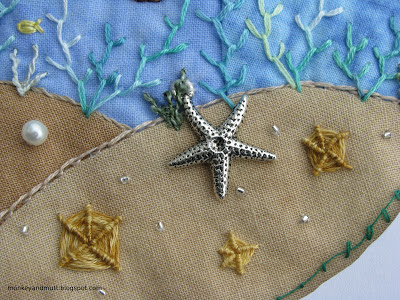 |
| A snowball for Nicki Lee |
You can see some of the amazing eye candy the CQI members have created on their blog. Just click here.
One of the swaps the group had going was a "Snowball Fight." Looking at these beautiful works of art, I have often thought I might like to join in, but I was still a little bit intimidated by the beautiful stitching the ladies in the group did.
A couple of weeks ago, I decided to step outside of my comfort zone and give it a try. I asked the group a few questions I had about the swap, and Nicki Lee was one of the first to reply. She also offered to be the first to trade snowballs with me.
Now, if you have seen Nicki Lee's work, you will understand why I felt like I had just won the lottery. (If you have not, here is a peek at her blog at Raviolee Dreams.)
It is a little bit intimidating to make something for someone when you admire their work, particularly when the theme of the block is one you have never attempted. However, we never know what we can accomplish if we are too afraid to try. So, I made my first attempt at a snowball with an under the sea theme.
 |
| Sea horse pattern from DMC Collection: Mini Motif Designs by Mary Bartley Stockett |
The cross-stitch designs are from a leaflet I purchased years ago, planning to make a hand towel. It is called DMC Collection: Mini Motif Designs: Exclusive Creation by Mary Bartley Stockett. (I was unable to find a leaflet online to share with you. It was published in 1993 by Graphworks International Inc.)
 | ||
| Conch pattern from DMC Collection: Mini Motif Designs by Mary Bartley Stockett |
This small, cd-sized block held many firsts for me.
1. This was my first hand-pieced block (I followed the piecing instructions from Allie Aller's Crazy Quilting: Modern Piecing & Embellishing Techniques for Joyful Stitching by Allie Aller. However, I did not trust myself to use my sewing machine for the curved seams and discovered that I actually enjoyed sewing it by hand!)
2. The block pieces are all curved.
3. It is an Under the Sea theme.
4. I used a coral stitch for the first time.
5. I finally attempted a whipped circle (using 5 spokes, hoping it would resemble a starfish.)
6. There are charms on the block.
7. Curiosity allowed me to discover a lazy daisy stitch combined with two straight stitches will, indeed, make a tiny fish.
It was a lot of fun to put this little underwater scene together. I hope Nicki Lee likes it!
Thank you for visiting my blog!
-Renee












































